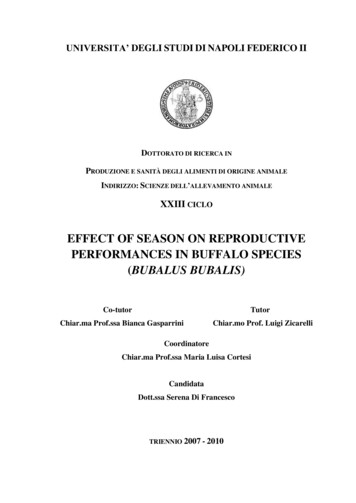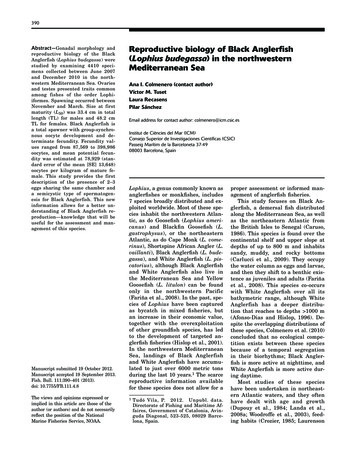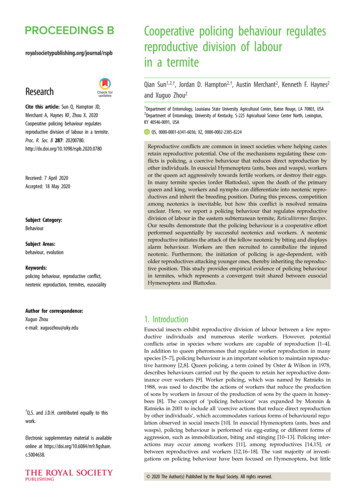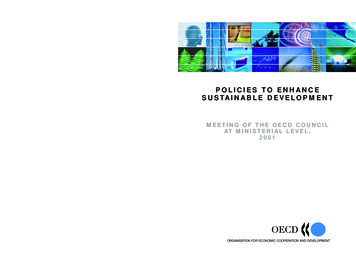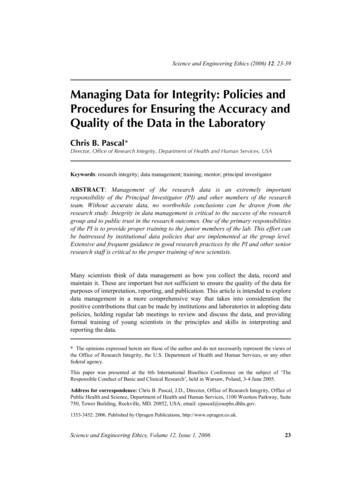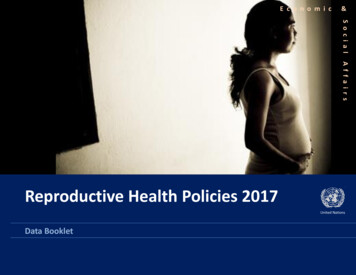
Transcription
E c o n o m i c&S o c i a lA f f a i r sReproductive Health Policies 2017United NationsData Booklet
Reproductive Health Policies 2017Reproductive health is critical to achievingthe Goals of the 2030 Agenda for SustainableDevelopment. This data booklet highlightscurrent policies on reproductive health andfamily planning, drawing on data published inWorld Population Policies Database: The 2015Revision. All information is available atwww.unpopulation.org.The Population Division of the Department ofEconomic and Social Affairs provides theinternational community with timely andaccessible population data and analysis ofpopulation trends and developmentoutcomes for all countries and areas of theworld. The Population Division has beensystematicallymonitoringpopulationpolicies, including those related toreproductive health, since 1974.Suggestedcitation:UnitedNations,Department of Economic and Social Affairs,Population Division (2017). ReproductiveHealth Policies 2017: Data Booklet (ST/ESA/SER.A/396).Cover photo: Copyright UN Photo/Martine Perret
Reproductive Health Policies 20171What is reproductive health?The 1994 Programme of Action of the International Conference on Population Development (ICPD) definesreproductive health as a state of complete physical, mental and social well-being and not merely the absence ofdisease or infirmity, in all matters relating to the reproductive system and to its functions and processes.Reproductive health care includes having access to a range of good-quality information and services: Family-planning counselling, information, education, communication and services, including access tosafe and effective contraceptive methods; Education and services for prenatal care, safe delivery and post-natal care, especially breast-feeding andinfant and women's health care; Prevention and appropriate treatment of infertility; Prevention of unsafe abortion1 and management of the consequences of abortion; Prevention and treatment of reproductive tract infections, sexually transmitted diseases and otherreproductive health conditions; Prevention of harmful practices, such as female genital mutilation; and Information, education and counselling, as appropriate, on human sexuality, reproductive health andresponsible parenthood.Copyright Photo/Eskinder Debebe1According to paragraph 8.25 of the ICPD Programme of Action, in no case should abortion be promoted as a method of family planning. Any measures or changes related to abortion within the health system canonly be determined at the national or local level according to the national legislative process. In circumstances where abortion is not against the law, such abortion should be safe.Reproductive health is central to the 2030 AgendaThe 2030 Agenda for Sustainable Development contains a number of targets related to reproductive health.Specifically, target 3.7 calls for ensuring universal access to sexual and reproductive health-care services, includingfamily planning, information and education, and the integration of reproductive health into national strategies andprogrammes by 2030. Likewise, target 5.6 calls for ensuring universal access to sexual and reproductive health andreproductive rights. Other targets in the 2030 Agenda related to reproductive health include reducing the globalmaternal mortality ratio to less than 70 per 100,000 live births (target 3.1); ending preventable deaths of newbornsand children under 5 years of age (target 3.2); and eliminating all harmful practices, such as child, early and forcedmarriage and female genital mutilation (target 5.3).Meeting the targets related to reproductive health can contribute positively to the achievement of other goals andtargets of the 2030 Agenda, including those related to poverty, health, education and gender equality.
2Reproductive Health Policies 2017Reproductive health care is important for preventing maternal and newborn deathsAccording to the World Health Organization (2016),approximately 830 women die every day from preventablecauses related to pregnancy and childbirth. Althoughmaternal deaths have been declining over the past decades,they remain a concern, particularly in the less developedregions. The maternal mortality ratio—defined as thenumber of maternal deaths per 100,000 live births—ishighest in sub-Saharan Africa (546 per 100,000 live births),followed by Oceania (187 per 100,000 live births). Bycomparison, the maternal mortality ratio in the moredeveloped regions is 12 per 100,000 live births. The SDGtarget 3.1 has called upon Governments to reduce globalmaternal mortality ratio to less than 70 per 100,000 livebirths by 2030.Providing antenatal care and ensuring that births areattended by trained health personnel contribute toreducing maternal deaths. However, in sub-Saharan Africaonly 51 per cent of births were attended by a skilled birthattendant in 2016, compared to 99 per cent of births inEurope and in Northern America. Globally, 79 per cent ofbirths were assisted by trained health personnel (UNICEF2017).Likewise, improved care around the time of birth reducesthe incidence of neonatal deaths. Some 40 per cent ofdeaths that occur within the first 28 days of birth could beavoided with interventions such as skilled birth attendance,emergency obstetric care, and newborn resuscitation(UNICEF 2015). In 2016, the global neonatal mortality ratewas 19 deaths per 1,000 live births. Neonatal mortality washighest in Central and Southern Asia and in sub-SaharanAfrica (28 deaths per 1,000 live births in both regions).Maternal mortality ratio, 2015Data source WHO, UNICEF, UNFPA, World Bank Group and UNPD (2015).Notes: The boundaries and names shown and the designations used on this map do not imply official endorsement oracceptance by the United Nations. Dotted line represents approximately the Line of Control in Jammu and Kashmiragreed upon by India and Pakistan. The final status of Jammu and Kashmir has not yet been agreed upon by the parties.Final boundary between the Republic of Sudan the Republic of South Sudan has not yet been determined. A disputeexists between the Governments of Argentina and the United Kingdom of Great Britain and Northern Ireland concerningsovereignty over the Falkland Islands (Malvinas). Based on 182 countries or areas with available data.Distribution of countries by percentage of births attended by trained health personneland by region, latest year availableData sources: UNICEF (2017).Notes: Based on 185 countries with available data.
Reproductive Health Policies 20173Most Governments have adopted measures to reduce maternal and newborn deathsThree out of four Governments (76 per cent) have adopted one or more policy measures in the past five years to reduce the number ofnewborn or maternal deaths. Africa is the region with the highest share of Governments with at least one measure to address newborn ormaternal mortality (100 per cent), followed by Latin America and the Caribbean (90 per cent) and Asia (75 per cent).Globally, more than 70 per cent of Governments have expanded the coverage of essential post-partum and newborn care (72 per cent),comprehensive prenatal care (71 per cent), obstetric care (71 per cent) or access to effective contraception (71 per cent). In addition, 62 percent of Governments around the world have adopted a policy to expand recruitment and training of skilled birth attendants, while 39 per centhave expanded access to safe abortion care, including post-abortion care.Percentage of Governments having adopted policy measures in the past five years to address newborn or maternal mortality by region, 201510010096897675Percentage6373 71 73 7371 72 7171Expanded coverage of obstetriccare87 87 87 847562Expanded coverage ofcomprehensive prenatal care9096 98 986350595055415045393325Expanded coverage of essentialpost-partum and newborn care69333650 50444438Expanded access to effectivecontraceptionExpanded access to safe abortioncare, including post-abortion care3126 26190WorldAfricaAsiaEuropeData source: United Nations, Department of Economic and Social Affairs, Population Division (2016).Note: Based on 190 countries with available data.Latin America andthe CaribbeanNorthernAmericaOceaniaExpanded recruitment and trainingof skilled birth attendantsAny of these measures
4Reproductive Health Policies 2017Family planning services are an important component of reproductive health carePercentage of women aged 15 to 49, among those who are married or in aunion, who are using any method of contraception, latest year availableThe United Nations Population Division (2017a) estimates thatglobally in 2017, 63 per cent of women of reproductive age (15-49)who are married or in-union were using some form ofcontraception. Contraceptive use varies greatly by region, rangingfrom a low of 36 per cent in Africa to a high of nearly 75 per centin Latin America and the Caribbean. Fifty-eight per cent of marriedor in-union women of reproductive age use a modern method offamily planning, constituting 92 per cent of contraceptive users.Access to safe, voluntary family planning can help couples andindividuals realize their basic right to decide freely and responsiblyif, when and how many children to have.Data source: United Nations, Department of Economic and Social Affairs, Population Division (2017b).Notes: Based on 194 countries or areas with available data for contraceptive prevalence.Most Governments provide direct support for family planningGlobally, 84 per cent of Governments provide directsupport for family planning, meaning that family planningservices are provided through government-run facilities oroutlets. Among the remaining Governments with availabledata, 9 per cent provide only indirect support for familyplanning, meaning that the Government does not providefamily planning services through government outlets, butinstead supports the private sector, including nongovernmental organizations, in providing those services.Only 6 per cent of Governments provide no support forfamily planning, meaning that the Government allows theprivate sector to provide family planning services withoutgiving it any material support. In addition, the Holy Seedoes not allow family planning programmes or serviceswithin its jurisdiction.Countries by type of Government support for family planning, 2015Data source: United Nations, Department of Economic and Social Affairs, Population Division (2016).Notes: The boundaries and names shown and the designations used on this map do not imply official endorsement oracceptance by the United Nations. Dotted line represents approximately the Line of Control in Jammu and Kashmir agreedupon by India and Pakistan. The final status of Jammu and Kashmir has not yet been agreed upon by the parties. Finalboundary between the Republic of Sudan the Republic of South Sudan has not yet been determined. A dispute existsbetween the Governments of Argentina and the United Kingdom of Great Britain and Northern Ireland concerningsovereignty over the Falkland Islands (Malvinas). Based on 197 countries with available data.
Reproductive Health Policies 20175Fewer than one in five Governments have a policy restricting access to contraceptiveservicesAmong 186 countries with information available, 19 per cent of Governments apply one or more restrictions on access to contraceptiveservices. Various kinds of restrictions exist, including requirements regarding the age and marital status of the person seeking access tocontraceptive services, and requirements for parental consent, as well as restrictions on access to emergency contraceptive pills or sterilization.Latin America and the Caribbean is the region with the highest percentage of Governments (31 per cent) restricting access to contraceptiveservices on the basis of at least one of these grounds, followed by Asia (25 per cent) and Europe (19 per cent).In terms of the specific measures, requiring parental consent for minors is the most common restriction (9 per cent), while restrictions relatedto the sterilization of women (3 per cent) or men (4 per cent) are the least prevalent. Latin America and the Caribbean (19 per cent) and Europe(14 per cent) have the highest percentage of Governments requiring parental consent for minors to access contraceptive services, while Asiahad the highest proportion of Governments restricting the sterilization of women (7 per cent) or men (14 per cent).Percentage of Governments with a policy restricting access to contraceptive services by type of policy measure and region, 201540Minimum ageMarital status31Parental consent (for minors)Emergency contraceptive pills30Sterilization of women25PercentageSterilization of men205577 7534444139891914141410Any of these measures1919555 55666200WorldAfricaAsiaEuropeLatin America andthe CaribbeanNorthernAmericaOceaniaData source: United Nations, Department of Economic and Social Affairs, Population Division (2016).Notes: Based on 186 countries with available data. Excludes cases where restrictions by minimum age, marital status or parental consent (for minors) could not be ascertained from available information.
6Reproductive Health Policies 2017Gaps persist in women’s access to family planningAlthough access to family planning has increased in recentdecades, the United Nations Population Division (2017a)estimates that, globally, 12 per cent of women ofreproductive age (15-49) who are married or in a unionhave an unmet need for family planning, meaning theywant to stop or delay childbearing but are not using anymethod of contraception. When users of traditionalmethods are considered as having an unmet need for familyplanning, 17 per cent of married or in-union womenworldwide are estimated to have an unmet need formodern methods in 2017. Many of the countries with highlevels of unmet need for family planning are in sub-SaharanAfrica.Percentage of women aged 15 to 49, among those who are married or in a union,who have an unme
Reproductive Health 3Policies 2017 98 71 50 Most Governments have adopted measures to reduce maternal and newborn deaths Three out of four Governments (76
